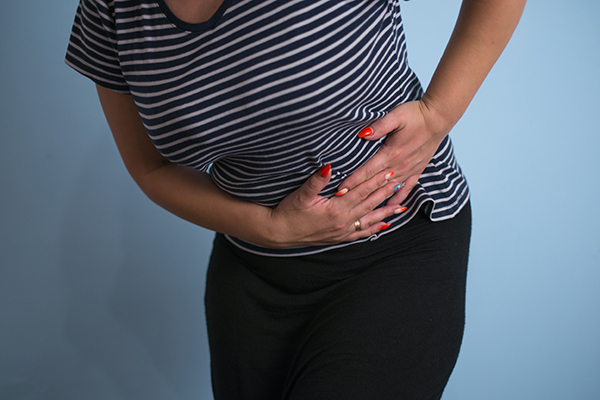Abdominal Cramps – a PCOS symptom
Experiencing cramps and pain during menstrual period is considered normal by many women, but to experience painful cramps when it is not time for the monthly periods can leave anyone puzzling. Studies have shown that cramps can occur even when one is not expecting their periods. Pelvic pains and cramps are not always linked to periods because they can occur due to other complications. However, painful or irregular periods are among the frequently occurring ovarian cyst symptoms.
PCOS or Polycystic ovarian syndrome is a complex yet common endocrine disorder that is caused due to hormonal imbalances. It is experienced in the form of:
- Hyperandrogenism – a condition in which women have higher levels of male hormone androgen.
- Insulin Resistance – a condition in which the cells of the body are no longer sensitive to insulin. This leads to poor absorption of glucose from the blood into the tissues
- Anovulation – This is a condition where ovulation does not take place. Chronic anovulation leads to infertility.
Hyperandrogenism leads to acne, and excess and unwanted body hair. Anovulation leads to irregular periods, ovulation-related infertility, amenorrhea, and polycystic ovaries. Insulin resistance leads to type 2 diabetes, higher levels of cholesterol, and an increased risk of cardiovascular diseases. PCOS is a complex disorder that can lead to long term health complications.
It can even lead to everyday difficulties with abdominal pain, heavy bleeding that leads to anemia, irregular periods and a host of other PCOS symptoms that can affect women in the reproductive years.
While PCOS has physical and psychological symptoms, one of the most cumbersome symptoms are having painful abdominal cramps even when there are no periods.
Why women have abdominal pain in PCOS
Many women with PCOS often complain of pelvic or abdominal pain. This pain is generally below the belly button and it is often accompanied by cramps. Pain can be moderate to severe, throbbing, dull/sharp, and can occur on one or both sides of the pelvis near the ovaries.
Abdominal pain and cramps is one of the ovarian cyst symptoms and occurs in some women. Ovarian cysts are small fluid-filled sacs that occur in most women at least once in their lifetime. However, these cysts are generally painless.
Ovarian cysts are known to cause symptoms including abdominal bloating, pain even when there are no periods, and pain during bowel movements and sexual intercourse. These symptoms occur when cysts grow bigger, or when the cysts are ruptured.
Women who experience pelvic pain even without menstruation should be evaluated by an endocrinologist and a gynecologist.
How are irregular periods and PCOS related?
The main characteristic feature of polycystic ovary syndrome (PCOS) is an increased production of male hormones in women. Even though both men and women have some amounts of both male and female hormones (testosterone and estrogen), PCOS is a condition characterized by the presence of excess androgens in women. This condition is known as hyperandrogenism and is one of the root causes of painful PCOS symptoms including irregular periods.
Higher levels of androgens create an imbalance of female sex hormones and leads to ovulatory infertility. In most cases, having irregular periods or no periods with cramps is a symptom of PCOS.
Some women with PCOS may have regular monthly cycle period each month. But a majority of them have erratic menstrual cycles. The average menstrual cycle occurs once every 28 days. However, if the menstrual cycle occurs in an interval of 21 or 35 days it is considered normal.
A woman is categorized as having irregular periods only if there are eight or lesser number of menstrual cycles per year, and when it takes more than 35 days for the next menstrual cycle.
In women without PCOS, a menstrual cycle occurs when there is no pregnancy. With the formation of eggs in the ovaries, the walls of the uterus thickens in order to facilitate pregnancy. When there is no pregnancy, the thickened walls come back to their normal thickness. This shedding of uterus wall thickness causes bleeding and menstrual cycles.
In women with PCOS, due to high levels of luteinizing hormone, the ovaries do not get signals to produce eggs leading to a chain of events and irregular periods.
Symptoms of irregular periods
Menstrual cycles do not behave the same for every women. Some women’s bodies work just like the clock while others are unpredictable. A woman gets her period every 21-35 days on an average. Having periods for a duration between two to seven days is considered normal.
Common symptoms of an irregular period include:
- Duration between each period starts to change
- A woman loses more or less blood during a period than usual
- The number of days the period lasts varies a lot
Types of irregular periods
- Oligomenorrhea: Menstrual cycles occurs at a frequency of more than 35 days
- Polymenorrhea: Frequent menstrual cycles shorter than 21 days.
- Amenorrhea: Lack of menstrual cycles. This is a common PCOS symptom that is caused due to anovulation.
- Dysmenorrhea: Menstrual cycles with severe pain, abdominal bloating, and pain.
In some cases, women have abnormal menstrual bleeding with the duration lasting up to 10 days with heavy bleeding.
Treatment for irregular periods
Depending on a woman’s medical history and personal goals, there are several different ways to get treated for irregular periods. Medications like oral contraceptives are prescribed in order to balance out hormones and create a regular menstrual cycle. Metformin (a diabetes medication) is also prescribed for irregular periods.
Often women with PCOS have higher body mass index with obesity. This can conflict with menstrual cycle. To treat irregular periods, a change in diet and exercise can be helpful to regulate periods and balance hormones in women with PCOS.
What to watch out for?
Irregular periods can pose a great threat to conceiving. Here are things to do track ovulation.
- Marking dates of the periods on the calendar.
- Checking cervical mucus for any changes. The mucus will be plentiful, slippery, stretchy, and clear as ovulation approaches.
- Checking body temperature each day. This can indicate when ovulation is occurring.
In case of any symptom or irregularity, an evaluation with a reproductive endocrinologist and a gynecologist is advised.














